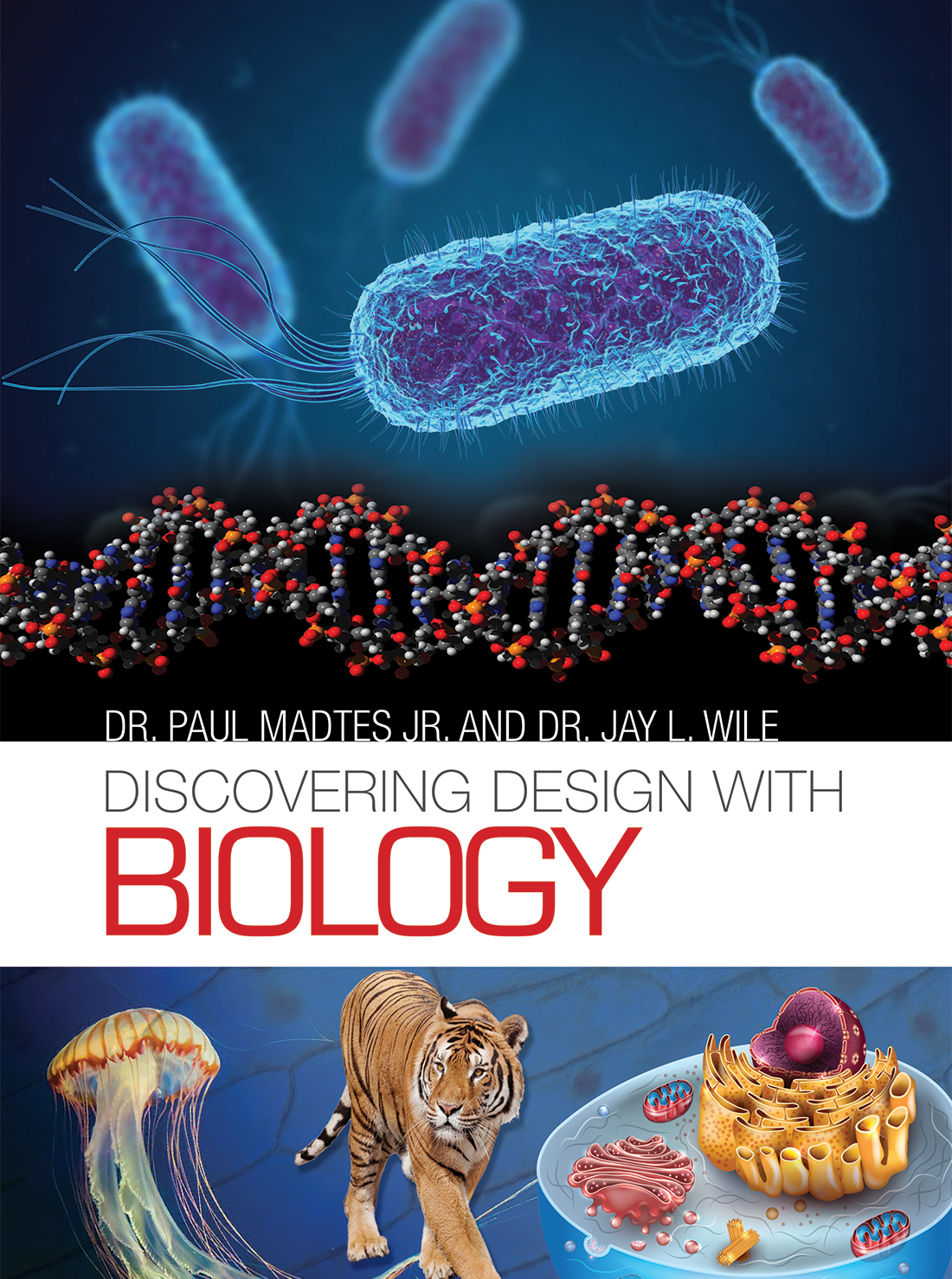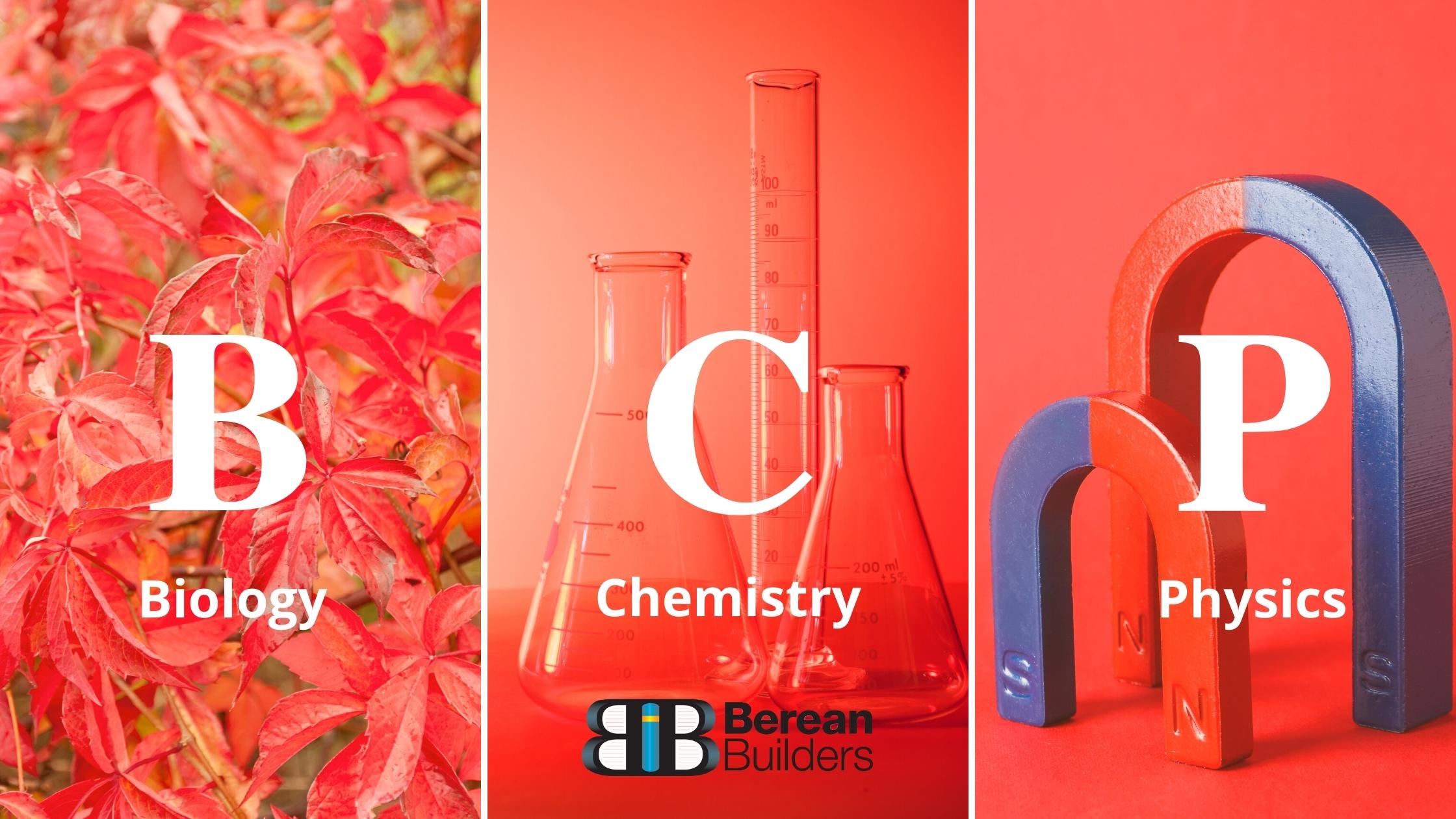
Dr. Wile has joined with Dr. Paul Madtes, university biology professor and lead author of the text, to bring you the latest in our science courses: Discovering Design with Biology.
As he explains in this blog post, Dr. Wile observed the original and second edition of the book Exploring Creation With Biology needed a refresh, but circumstances arranged themselves to allow for Dr. Wile and Dr. Madtes to write a completely new biology text that is lab-based and prepares your student for college level biology.
Like Discovering Design With Earth Science, Discovering Design With Biology gives glory to the One who created it all.
And because the lead author is a biologist, the book “builds biology from the ground up” beginning with molecules and cells and progressing through to animals, plants, and the ecosystems and biomes they inhabit.
You will find beautiful full-color images, easy-to-understand explanations, and user-friendly experiments in every chapter. The experiments are designed specifically to increase understanding of the biological concepts in the text.
Some of the experiments require particular items available in the optional lab kit. Follow this link for a list of materials included in the kit for the lab experiments, as well as the items you’ll need to provide.
Table of contents list
Scope and sequence
Let’s explore the chapters and the science contained inside.
Introduction
The introduction contains a thorough explanation of how to get the most out of your Discovering Design with Biology book, experiments, and worksheets and how to incorporate science study in your homeschool schedule.
It covers the importance of including hands-on learning through experimentation. It also stresses the need to keep up with notes and record the results of experiments performed.
We want to make sure your student has access to as much support as needed. Dr. Wile is available to answer questions through a dedicated website for students that also contains searchable questions and answers.
Chapter 1 Introduction to Biology

Chapter 1 explains the layout of the units in the book then dives into the basic definition of life. Each section further explains the characteristics living organisms have and how biologists organize these features, including how they come up with the names of organisms. Your student will get a review of the scientific method and how to conduct experiments, plus discover how energy flows through the living world. Finally, the chapter discusses natural selection’s role in biological adaptation.
Chapter 2 The Chemistry of Life

This chapter explores the chemical building blocks of life from atoms to compounds and how these chemicals are arranged in living organisms. There is a section devoted to water and its characteristics, and the chapter introduces groups of molecules and their functions necessary for life.
Chapter 3 Cells

Building on the previous information, this chapter explains the complexity of cells and how they are made up of complex molecules and biomachines. It investigates the multitude of cell types and their functions in living things including energy exchange, protection, and osmosis, all pointing to an intricate design that allows cells to function properly.
Chapter 4 Cell Division

Once your student understands cells, they are ready to explore how cells divide and reproduce. This chapter takes them through the cell cycle and discusses the differences between animal and plant cells. It also discusses chromosomes and the human life cycle. There’s even a section on AI and the difficulties robots would face trying to replicate themselves.
Chapter 5 Genetics

This chapter breaks down genetics and how traits are passed down from parent to offspring beginning with the simple experiments of Gregor Mendel and working through nature vs. nurture. Your student will discover how each can affect the outcomes of reproduction including mutations and other genetic abnormalities.
Chapter 6 Biotechnology

Our bodies and all living creatures have systems in place to protect from biological invaders such as viruses by destroying important parts of the molecules. Science has created technology that they use to take apart and reconstruct biological molecules to engineer compounds and processes that can keep us healthy. Some topics include insulin, cancer treatments, and gene therapy, plus the bioethics of this technology.
Chapter 7 Microbiology – Archaea and Bacteria

Now the course dives into the world of microbes and investigates their hidden world via a microscope. Your student will get to culture some bacteria in an experiment, then go on to explore organisms that live in extreme environments as well as those microbes that can make us sick.
Chapter 8 Microbiology – Protists and Fungi

This chapter introduces your student to the “miscellaneous” section of living organisms and explain why they are so difficult to categorize. It also explores different types of protists and fungi and explains their characteristics, such as amoeba, plankton, algae, yeast, mold, and mushrooms. It finishes up with symbiosis in the fungal world as well as diseases caused by fungi.
Chapter 9 Invertebrates

Time to move on to organisms without backbones and get a brief overview of their characteristics: corals, jellyfish, worms, starfish, snails, shellfish, and insects. This chapter covers the biological makeup of these creatures and their likely habitats, then gives your student a chance to dissect a crayfish.
Chapter 10 Vertebrates: Fish and Amphibians

The next group of animals the course explores includes fish, frogs, toads, and salamanders, plus takes a look at their habitats, eating habits, and reproductive cycles. It also considers the evolutionary model that suggests fish evolved into amphibians and why this may not be possible.
Chapter 11 Reptiles, Birds, and Mammals

Now the course investigates the vertebrate groups of the snakes, lizards, turtles, dinosaurs, all kinds of birds, and mammals from mice to whales, plus the characteristics of each, and the varied environments they inhabit. The chapter also covers reproductive cycles including hatching eggs, pouch-dwelling offspring, and placental mammals and investigates the problems with the evolutionary theory of dinosaurs becoming modern birds.
Chapter 12 Primates and Humans

Finally, this chapter covers the last of the animal classes, primates. It discusses the characteristics of apes, monkeys, chimpanzees, and gorillas. And while humans are indeed considered primates, they are described separately. The chapter breaks down the major systems of the human body and discusses the importance of each and ends with a discussion of what it means to be created in the image of God.
Chapter 13 Plants – Anatomy and Classification

The course moves from animals to plants in this chapter and describes their cellular and tissue structure of leaves, stems, roots, and flowers, and how plants are classified. It also explores the varied ways plants reproduce themselves.
Chapter 14 Plants – Physiology

Once your student understands the structure of plants, they’re ready to learn how plants behave. From photosynthesis to pollination to germination and growth, this chapter reveals the physiology of plants throughout the days and seasons. The chapter concludes with a discussion of how some countries have bestowed certain legal rights to flora under their control, and why this does not align with biblical teachings.
Chapter 15 Environmental Science

Now that the course has covered the living creatures in our world, it moves on to discuss how the physical world impacts the organisms in it and vice versa. It covers the ecological pyramid and explores how energy flows from one group to another. Next up, the text covers global biological cycles that stem from weather and the cycles of carbon, nitrogen, and phosphorous around the globe. It also discusses climate, soil, and biodiversity, which contribute to the availability (or not) of important natural resources, and the various stresses and threats to nature.
Chapter 16 Ecosystems

Finally, the course takes all the separate parts it presented in the previous chapters and blends them to help your student understand how living organisms interact with their surroundings in different biomes. As species live either independently, cooperatively, or competitively, they thrive or decline according to the resources in their ecosystem. The chapter refers back to concepts presented to tie all the biological information together.
Lab-Based Biology

There are a total of total of 38 experiments that require roughly 40 hours of laboratory work. Of those experiments, 17 use household items. These include extracting DNA from fruit, determining the effects of temperature and pH on proteins, exploring reflexes, and exploring the effect of surface area on diffusion.
There are 14 experiments that use a microscope kit, including identifying different stages of mitosis, examining bacteria cultures, studying blood, and studying invertebrates. The other 7 experiments use a dissection kit and include the earthworm, crayfish, fish, and frog. See the complete lab supplies list here.
Get Started with Discovering Design With Biology
In addition to solid science and thought-provoking questions, this set includes printable Worksheets as well as a Student Notebook for exploring questions and keeping track of chapter review answers.
If this looks like the perfect biology book for your student, take a look at Discovering Design With Biology today.



















